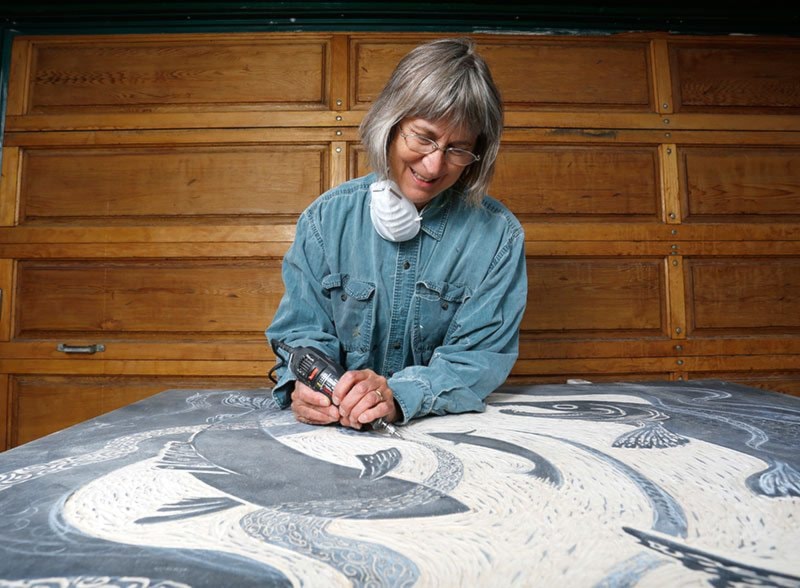Making a relief print requires four basic things: ink, paper, a design carved into a plate and a little bit of pressure.
Or, in the case of 15 Yukon artists taking over the Shipyards Park skating oval next week, a lot of pressure.
After all, why use your hands to press the ink onto the paper when you’ve got a 6,000-pound streamroller to do the work for you?
Artists from around the territory have each painstakingly carved designs into 100- by 120-centimetre panels of plywood.
From Aug. 5 to 7, at the aptly named Art Under Pressure those panels will be inked up and pressed onto paper with the help of the construction equipment normally used to smooth asphalt.
“The process itself is really interesting and for some people it’s something they’ve never seen or even thought of before,” said artist Linda Leon, who is helping to put the event together.
“It is impressive. Anything with big machinery is impressive.”
This is the event’s second year in the Yukon. In 2013, 18 artists created prints that were eventually part of a show at the Yukon Arts Centre.
A wooden brace on the ground holds the inked plates still. The paper goes on top of that, followed by a blanket and a second piece of plywood.
That’s what the steamroller goes over.
“When the reveal happens and you pull back your piece it’s a big ohhhh (from the crowd),” said printmaker Joyce Majiski.
The technique isn’t that different from the potato stamp art made in kindergarten classrooms across the country.
Artists chip away at their panel and anything that hasn’t been carved down will get covered in ink and appear on the paper.
“It was so much fun the first time. To make a print that size is rare,” Majiski said.
“It’s fun to work big.”
The prints are being pressed using oil-based ink onto high-quality Stonehenge art paper.
This year’s plywood is an upgrade from the first go-around. This year it’s a Baltic wood originally from Russia. The new plywood is less likely to chip compared to what was used in 2013, Leon said.
Majiski said artists are more than willing to give the technique a try.
“How can you say no to that? Come and play with us.”
Working on such a large scale just takes a bit of planning, Leon said.
A lot of artists will draw on their wood with a Sharpie or other pen in the areas they don’t want to remove, she said.
“When you’re down there, the sawdust is flying and it’s really easy to lose the part that you’re supposed to keep.”
Leon estimates she spent 48 hours working on the panel she created in 2013. This year’s piece is about half done and was created using a utility knife and small Dremel tool.
When it’s done, Leon’s print this year will be of three salmon. Her print in 2013 was also fish-related.
“I keep going down to the fish ladder, and looking at those salmon and thinking about them. Thinking about migration and what they go through to come all this way upstream to spawn. It’s a miracle that they make it.”
Leon is approaching local businesses to find places to hang the the finished prints for a month. “Only ones with really big walls,” she said.
The steamroller will be rolling out prints from 11 a.m. to 3 p.m. each day.
Leon said families love to come out and see the big machines being put to work.
“To see this big machine lumbering over the whole deal was awesome, in the original meaning of the word.”
Contact Ashley Joannou at
ashleyj@yukon-news.com
